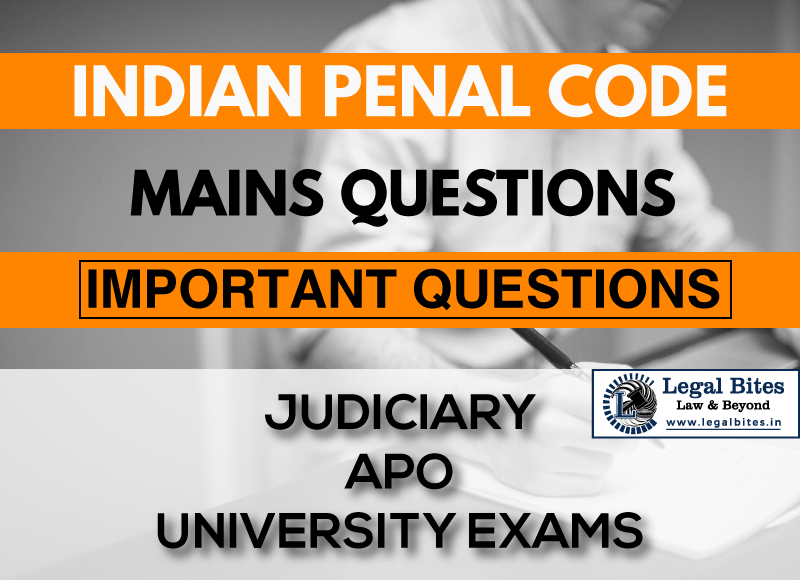Define, illustrate and explain the offence of criminal intimidation. In what way extortion is different from criminal intimidation?
Question: Define, illustrate and explain the offence of criminal intimidation. In what way extortion is different from criminal intimidation? [U.P.H.J.S. 2012, CG. C.J. 2010, UPCJ 2000] Find the answer to the mains question only on Legal Bites. [Define, illustrate and explain the offence of criminal intimidation. In what way extortion is different from criminal intimidation?] Answer Section 503,… Read More »

Question: Define, illustrate and explain the offence of criminal intimidation. In what way extortion is different from criminal intimidation? [U.P.H.J.S. 2012, CG. C.J. 2010, UPCJ 2000] Find the answer to the mains question only on Legal Bites. [Define, illustrate and explain the offence of criminal intimidation. In what way extortion is different from criminal intimidation?] Answer Section 503, which defines the offence of criminal intimidation, describes the following essentials of...
Question: Define, illustrate and explain the offence of criminal intimidation. In what way extortion is different from criminal intimidation? [U.P.H.J.S. 2012, CG. C.J. 2010, UPCJ 2000]
Find the answer to the mains question only on Legal Bites. [Define, illustrate and explain the offence of criminal intimidation. In what way extortion is different from criminal intimidation?]
Answer
Section 503, which defines the offence of criminal intimidation, describes the following essentials of the offence of criminal intimidation. These are-
1. there should be a threat of injury to a person-
- to his person, reputation or property; or
- to the person, or reputation of anyone in whom that person is interested;
2. the threat must be with the intent–
- to cause alarm to that person; or
- to cause that person to do any act which he is not legally bound to do as the means of avoiding the execution of such threat; or
- to cause that person to omit to do any act which that person is legally entitled to do as the means of avoiding the execution of such threat.
In simple terms, what the offence defines is that if any person threatens another with injury to his person, property or reputation, and to avoid that, the other person is made to do an act he is not legally bound to do or to omit to do something he is legally bound to do, or which caused alarm to that person, then that person is said to have committed criminal intimidation.
In short, it is extending a threat to another, which results in a particular set of actions from the other as a means of avoiding the threat. However, a mere threat does not amount to criminal intimidation. It must be made with intent to cause alarm to the person threatened.
It is immaterial whether it has alarmed the recipient of the threat. The intention is the soul of the definition of criminal intimidation and it needs to be gathered by surrounding circumstances.
The difference between Criminal Intimidation and Extortion are outlines on below essential points:
- In extortion, the immediate object is obtaining money or money’s worth; in criminal intimidation, the immediate purpose is to induce a person to threaten to do or abstain from doing something, which he was not legally bound to do or omit.
- Extortion is committed in the presence of the offender and the victim is fear-induced to deliver up the property. In criminal intimidation, the threat need not be directly addressed to the person intended to be influenced. If it reaches anyhow, the offence is complete. Again, in criminal intimidation, the threat need not have actually produced any expected effect, still, the intimidator will be liable.
- In extortion, the delivery of property is the essence of the offence. In criminal intimidation, there is no delivery of any property from the victim to the accused.
The scope of section 503 was elaborated by the Supreme Court in Ramesh Chandra Arora v. State [AIR 1960 SC 154]. In this case, the appellant-accused had been charged with criminal intimidation by threatening a person X and his daughter of injury to their reputation by making public a nude photograph of the daughter unless ‘hush money was paid to him.
The intent was to cause alarm to them. The evidence, however, disclosed that the real intention was not to merely cause alarm but to force X to pay ‘hush money. The accused was held for criminal intimidation.
Important Mains Questions Series for Judiciary, APO & University Exams
- IPC Mains Questions Series Part I: Important Questions
- IPC Mains Questions Series Part II: Important Questions
- IPC Mains Questions Series Part III: Important Questions
- IPC Mains Questions Series Part IV: Important Questions
- IPC Mains Questions Series Part V: Important Questions
- IPC Mains Questions Series Part VI: Important Questions
- IPC Mains Questions Series Part VII: Important Questions
- IPC Mains Questions Series Part VIII: Important Questions
- IPC Mains Questions Series Part IX: Important Questions
- IPC Mains Questions Series Part X: Important Questions
Admin Legal Bites
Legal Bites Study Materials correspond to what is taught in law schools and what is tested in competitive exams. It pledges to offer a competitive advantage, prepare for tests, and save a lot of money.

